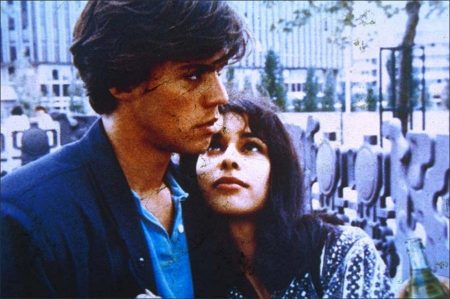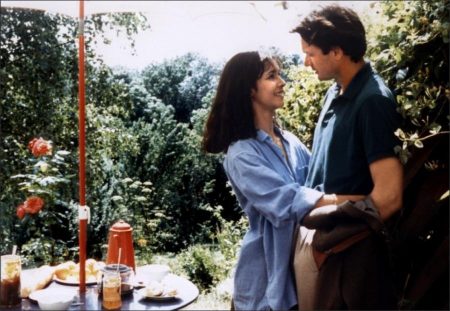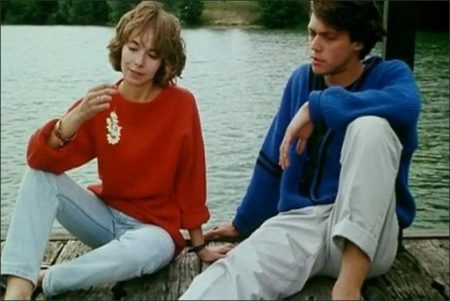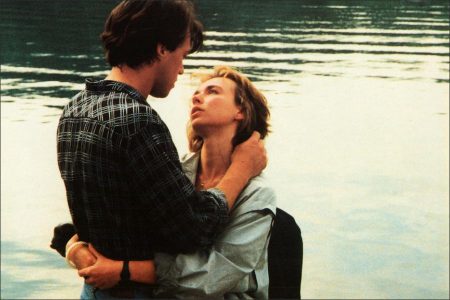L’Ami de Mon Amie movie storyline. Blanche is freshly installed in Cergy-Pontoise, a trendy new town near Paris. She has a new apartment, a new job with no one over and no one under her. She meets Léa at lunch one day, and soon she meets an acquaintance of Léa, Alexandre, who she approaches somewhat awkwardly.
The movie then follows the time-honored plot of exchange of relationships, as Blanche and Lea switch boyfriends. The name L’ami de mon amie would then literally mean the friend (male) of my friend (female) or perhaps the boyfriend of my girlfriend, ami meaning friend, boyfriend in this case, and amie being the female of the word ami with the same general and intended meanings.
My Girlfriend’s Boyfriend (French title: L’Ami de mon amie, also known as My Girlfriend’s Boyfriend) is a 1987 comedy film directed by Éric Rohmer. The film stars Emmanuelle Chaulet, Sophie Renoir, Anne-Laure Meury. The theme is the proverb “Les amis de mes amis sont mes amis” (“My friend’s friend is my friend”)
Review for L’Ami de Mon Amie
LEAD: SPECIFIC places, at specific times of year, have always been key to the methods and the manners of Eric Rohmer’s splendidly singular comedies. In ”My Night at Maud’s,” the wintry, non-picturesque streets and chilly apartments of the city of Clermont-Ferrand had the effect of prompting characters to argue long into the night, as if to stay out of cold, lonely beds.
SPECIFIC places, at specific times of year, have always been key to the methods and the manners of Eric Rohmer’s splendidly singular comedies. In ”My Night at Maud’s,” the wintry, non-picturesque streets and chilly apartments of the city of Clermont-Ferrand had the effect of prompting characters to argue long into the night, as if to stay out of cold, lonely beds. The lush, midsummer Annecy countrysides in ”Claire’s Knee” were an overwhelming aphrodisiac to an otherwise rational man. In ”Pauline at the Beach,” the sunlit crispness of the Normandy coast, at the end of the season, required that the characters stop talking around points and come to decisions before facing another autumn at loose ends in Paris.
Mr. Rohmer, the most cerebral, most morally committed of French directors, is also the one who seems most aware of the particular influences of geography and meteorology on people. In a Rohmer movie, the physical world, including architecture, describes the life of the mind.
The spectacular satellite city of Cergy-Pontoise, designed by the Argentine architect Ricardo Bofill, is the unbilled co-star of ”L’Ami de Mon Amie” (”My Girlfriend’s Boyfriend”), Mr. Rohmer’s small, perfectly achieved new addition to the series of films he calls ”Comedies and Proverbs.” The film will be shown at the New York Film Festival tonight at 6:15 and tomorrow at 9 P.M.
From what Mr. Rohmer shows us, Cergy-Pontoise is a kind of under-populated, modernist amalgam of Bath, a French co-op city and a Disneyworld. The old world – Paris -hovers on the horizon. Mr. Rohmer, as much as the intense, well-meaning, sometimes seriously muddled lovers in the film itself, is fascinated and rather charmed by this bold architectural attempt to create, at one blow, a perfect environment: office and apartment buildings of glass, steel and reinforced concrete, separated by strategically located plazas and parks, along with shopping areas, 15 television channels, three legitimate theaters, restaurants, a couple of manmade lakes and other recreational facilities.
Mr. Rohmer remains resolutely unhorrified by it all. He appreciates this particular example of urban planning, while sometimes finding it as exotic as an Eskimo village and as funny as a miniature golf course.
Cergy-Pontoise was designed for community. ”It’s like a village,” Fabien says to Blanche about Cergy-Pontoise, after running into Blanche near a shopping center several times within the same afternoon. Fabien is the lover of Lea, Blanche’s best friend.
Fabien and Blanche, who scarcely know each other, feel guilty as well as pleased at these chance encounters, dictated not by fate but by the satellite-city’s layout. In addition, Blanche is more than a little troubled because Lea has confided that she’s tired of Fabien, and wishes she could leave him ”in easy stages.” Lea thinks that Blanche and Fabien would make a fine match.
Blanche, however, thinks she’s in love with Alexandre, an engineer with the local power-and-light company, a man so handsome and self-assured that women chase him. In the course of one idyllic summer in this architectural paradise, Blanche, Fabien, Lea and Alexandre scheme to achieve their own ends without damaging friendships. That they will succeed is no surprise. The fun of ”L’Ami de Mon Amie” is watching how close they come to the edge of failure, and the manner in which Cergy-Pontoise reveals character and rules choices.
The solemn Blanche, played by Emmanuelle Chaulet, an extremely pretty new actress making her film debut, loves the arid newness of Cergy-Pontoise. She’s lonely but, most of the time, she’s as confident that she’ll find the ideal man as she is that grass will eventually be planted in the satellite city’s unfinished plazas. Fabien (Eric Viellard), who considers himself an all-around sportsman, courts Blanche by taking her wind-surfing on a small manmade lake where the winds seldom get up to eight miles an hour. Wind-surfing here is mostly a matter of being able to stand up on utterly placid water.
Lea (Sophie Renoir, a brunette beauty) keeps making halfhearted attempts to leave Cergy-Pontoise, and keeps returning. In Paris, Alexandre (Francois-Eric Gendron) would be just another good-looking bureaucrat. In Cergy-Pontoise, he’s a celebrity. ”L’Ami de Mon Amie” looks and sounds serene, but there are summer storms threatening within.
Don’t be put off by being aware of the click of heels on floors, the whisper of mild breezes, of the silences between earnest and frequently misunderstood confidences. Listen to what’s being said. Everyone talks very well but often at hilarious cross purposes. Mr. Rohmer must be the master of the oblique love scene, in which two people who care terrifically for each other manage to convince each other that they are not in love.
Blanche refuses to understand her own emotions, but she sees everything else clearly. Talking about Cergy-Pontoise’s manmade beach on a crowded Saturday, Blanche says -referring to the overpowering smell of hot dogs – that being there is like traveling in a foreign country. She puts up with things in Cergy-Pontoise that she wouldn’t tolerate anywhere else.
L’Ami de Mon Amie (1987)
Directed by: Éric Rohmer
Starring: Emmanuelle Chaulet, Sophie Renoir, Anne-Laure Meury, Eric Viellard, François-Eric Gendron
Screenplay by: Éric Rohmer
Production Design by: Sophie Mantigneux
Cinematography by: Bernard Lutic
Film Editing by: María Luisa García
Music by: Jean-Louis Valéro
Distributed by: Orion Classics
Release Date: August 16, 1987
Views: 309







